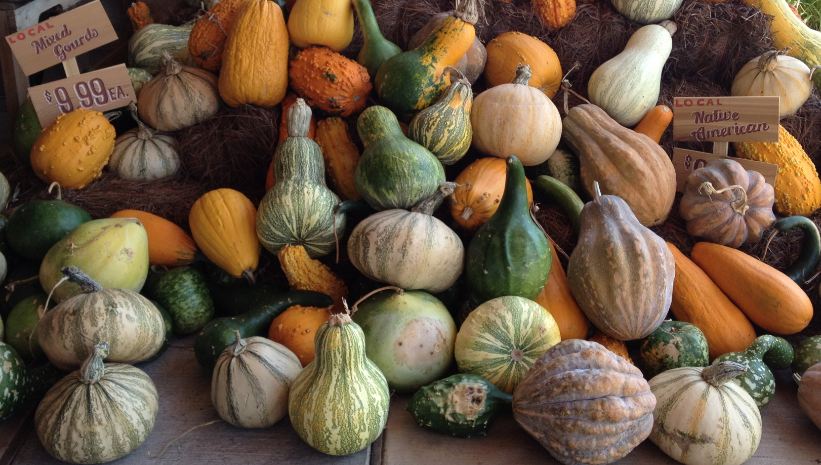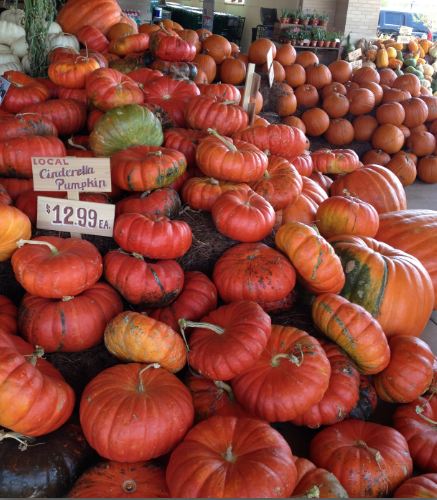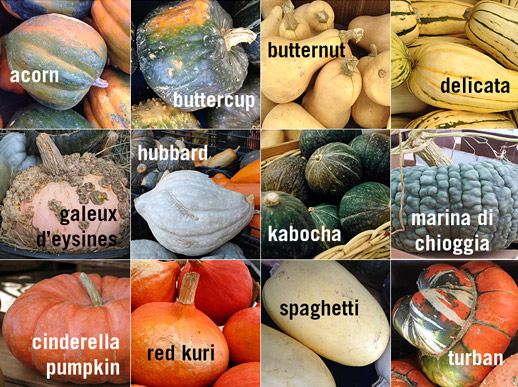Here is your Guide to Winter Squash from CUESA
If you’re a Farmer’s Market sort of person, you know that Fall and Winter yield mass quantities of squash! Pumpkins, acorn, butternut, you name it, it is probably there for the picking! What the heck do you do with this gorgeous gems?
I found this really awesome non-profit site out of San Fransisco called the Center for Urban Education about Sustainable Agrigulture, or CUESA. I was so stoked when I found their site, because it seemed to me that they are doing all of the right things to bring urban gardening, education and farming to the city! I love it! CUESA’s mission sort of reminds me of what Arcadia Farms is doing right here in Northern Virginia, and that makes me really happy; I love even more that they teach, create partnerships and bring value to their community through everything that I feel like I strive to do in my business and community partnerships. It was exciting to me to find such an organization, even though they deal directly with farming, and I deal with real estate, I know that education is paramount in all that we do. To keep things light, I thought I would share one of their pieces they put out recently about the abundance of Winter Squash and what these delectible little gems are, and what you can do with them, aside from adorn your tabletop during the holiday season! Thanks to CUESA for doing what you do I can’t wait to make the quest out to see what you all are up to!
 Acorn: These small, ridged squash are popular and versatile, ideal for just about any squash preparation. With hard skin and sweet orange flesh, Acorns can be found in a variety of colors, from deep green to gold or white. The small, colorfully striped Carnival squash, a hybrid of the Acorn and the Sweet Dumpling, is perfect for stuffing.
Acorn: These small, ridged squash are popular and versatile, ideal for just about any squash preparation. With hard skin and sweet orange flesh, Acorns can be found in a variety of colors, from deep green to gold or white. The small, colorfully striped Carnival squash, a hybrid of the Acorn and the Sweet Dumpling, is perfect for stuffing.
Buttercup: A popular variety of Turban squash (see below), the Buttercup is squat and pumpkin-shaped with faintly streaked, dark green skin. The flesh is sweet-potato-like and somewhat dry.
Butternut: The pear-shaped Butternut has dense, sweet, and nutty flesh and only a few seeds, making it a popular cooking squash to roast, mash, or purée in soups. To remove its hard exterior, first cut it in half and roast it, then remove the skin with a vegetable peeler. Waltham is the classic cream-colored variety.
Delicata: The small, oblong Delicata is a single-serving squash. Just cut in half, scoop out the seeds, and roast with a bit olive oil, salt, and pepper, or bake stuffed with the savory filling of your choice. No need to peel; the thin, green-and-gold-striped skin is edible, too. Sweet and creamy, it has earned itself the nickname “sweet potato squash.”
Galeux d’Eysines: Commonly known as the “peanut pumpkin,” this striking French heirloom has a salmon-colored skin covered in barnacle-like knobs. The growths are produced through a process known as “corking,” whereby the sugars break through the skin and exude to form peanut-shell-like scabs, a sign of the squash’s sweetness.
Hubbard: With blue-gray, bumpy skin and a teardrop shape, this heavyweight of the squash family has a pumpkin-like flavor. The Hubbard’s family-size heft makes it a favorite for roasting, and thus a great turkey substitute at a vegetarian Thanksgiving.
Kabocha: Similar to the Buttercup, this Japanese variety (kabocha is the generic term for squash in Japanese) has dense flesh and a tough, inedible skin. The deep yellow flesh is a bit flaky but very sweet. Bake it or roast with lots of butter or oil.
Marina di Chioggia: This heirloom hails from the coast of Italy, from the same village as the candy-striped Chioggia beet. Pumpkin-shaped, with a warty, dark blue-green exterior, the Marina di Chioggia has a decorative appearance, but its sweet flesh is especially good for ravioli and gnocchi filling.
Pumpkin: Pumpkins generally fall into two categories: those for carving and those for eating. Field pumpkins sold for Halloween jack-o’-lanterns usually lack flavor, while Sugar Pie pumpkins hold true to their name. Squat and richly hued French heirlooms like the Cinderella pumpkin (Rouge Vif d’Etampes) and Musquee de Provence are beautiful to display, but they’re also sweet and delicious roasted.
 Red Kuri: Resembling a small Hubbard with deep red-orange skin, the Red Kuri is a Japanese squash with a chestnut-like flavor. It’s a versatile fruit, and its bowl-like seed cavity works well for stuffing.
Red Kuri: Resembling a small Hubbard with deep red-orange skin, the Red Kuri is a Japanese squash with a chestnut-like flavor. It’s a versatile fruit, and its bowl-like seed cavity works well for stuffing.
Spaghetti: Light yellow, large, and oblong, the Spaghetti squash is another classic variety. When cooked, the light, stringy flesh gives way to strands that make for a delicious gluten- and carb-free pasta substitute. Just scrape the flesh with a fork.
Turban: Also known as Turk’s Cap, this bulbous and squat cucurbit makes a colorful addition to any fall centerpiece. Not to be mistaken for a decorative gourd, Turbans are edible, with a sweet, if mild, flavor. A Turban’s flesh is great roasted and made into a soup, and its rind can be used for a tureen.
Squash dishes around NoVa
Want to know where I have found some of the best butternut squash soup in Northern Virginia? Rustico in Ballston. It was divine. Velvet. Buttery. Delicious. I wanted more, but I think that the bowl, after being licked clean felt nearly violated. Pumpkin muffins have been decadent at Northside Social and I think that they deserve seconds. I will have to say that my very own personal pumpkin pie is pretty darned good and I have even been so kind as to share the recipe with my clients along with some of the precious little sugar-pie pumpkins that I procured from the Amish Market when I went to my in-law’s home in New Jersey! Organic, sugar pumpkins make some delicious pie!
What is your favorite squash recipe? Do you grow your own squash? I want to hear about your awesomeness. Plus, give back to CUESA and our local Arcadia if you can!

